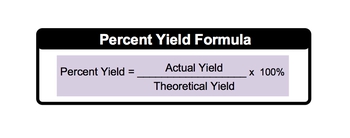Now, stoichiometry is a way of us determining theoretically on paper how much product we could make if we are given some amount of starting material. But when we do the experiment in real life and obtain a certain amount of product, it's the percent yield that determines how successful we were. Percent yield determines how successful the scientist was in creating their desired product. The higher the percent yield, then the higher the efficiency of a chemical reaction. So, just like you want the highest possible percentages on an exam, we want the highest possible percentages in percent yield, that will show us being successful in creating our product. We can describe percent yield values as excellent, very good, good, and poor. If you have a percent yield that is equal to or greater than 90%, you could call that an excellent yield. If you have an amount that's equal to or greater than 80 percent, then that would be very good. If you were good, that means you would be equal to or greater than 70%. And then you'd have a poor yield if your percent yield was less than 40%.
Now, with percent yield comes the percent yield formula. And the percent yield formula equals actual yield over theoretical yield times 100. Remember, we have our purple box here. That means that this is a formula you need to commit to memory because oftentimes it's not given on your formula sheet. Now, we know that the percent yield measures how successful we are in terms of carrying this reaction out in real life. We know that theoretical yield is what we do as calculations on paper when they give us multiple amounts of given, and we figure out how much product we're making. Actual yield, though, actual yield is the amount of pure product actually created when the experiment is done in the laboratory. Often, what you do on paper, you'll find that when you do the experiment in real life, things don't exactly match up. We're going to say here that the units used in the formula are based on the units of the actual yield. So, let's assume that our actual yield is in grams of our product, but our theoretical yield that we calculated is in moles. You'd have to change those theoretical yield units to match the actual yield unit. So you have to change moles to grams.
We're going to say here that no chemical reaction is 100% efficient. So you'll never get a percent yield that is 100%. There's always going to be something that happens. You may spill some of your compound, lose some randomly, or outside forces might play a part. So you'll never achieve a 100% yield. Because of this, that means that your actual yield is always less than your theoretical yield. So, just remember, we have percent yield, we have actual yield, and we have theoretical yield. Together, they give us a good insight into how efficient our chemical reaction is.


